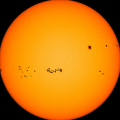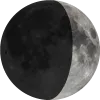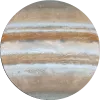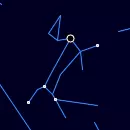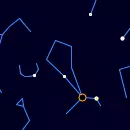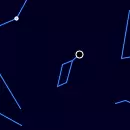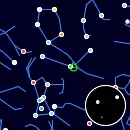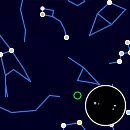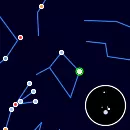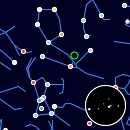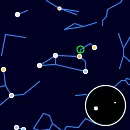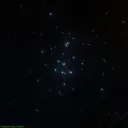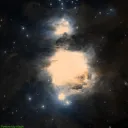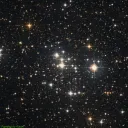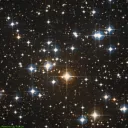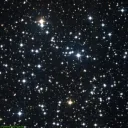Sky Tonight
Whether you're using just your eyes, binoculars, or a telescope, the night sky offers endless wonders waiting to be discovered. Happy stargazing!Sky Map
Celectial bearing and elevation at 20:54
This skymap is a dynamic visualization that displays the positions of celestial objets in the night sky for your specific location on the current date. It allows you to interactively explore the celestial landscape by moving it horizontally, enabling you to preview how the arrangement of stars will change as the night progresses.
Celestial Delights for Your Night Sky Adventure
Tonight's celestial wonders are ready to amaze and inspire. Here's a brief list of what you can explore:
Solar System Objects
Moon
3rd Quarter (54%)
The Moon exhibits a stunning array of craters, mountains, and lunar maria, showcasing its rugged and varied surface in intricate detail, with phases changing as it orbits Earth.
Planets
See which planets are currently visible, along with their rise and set times, to help you plan your observations.
Active Meteor Showers
The sky is quiet at the moment, with no major meteor showers underway.
For a complete list of meteor showers, go to our Active Meteor Showers page.
Satellite Flyovers
A short list of upcoming brightest satellite flyovers.
No bright satellite flyovers are expected in the next hour.
To view the complete list, visit our Satellites page.
Brightest Stars
Check out the five brightest stars currently visible in the night sky.
Sirius
Star
Sirius is the brightest star in the night sky, a binary star system located in the constellation Canis Major. Its brilliant white light is easily visible from Earth.
Arcturus
Star
Arcturus, the fourth brightest star, is an orange giant in the constellation Boötes. Its distinctive hue and brightness make it easily recognizable in the night sky.
Vega
Star
Vega, the fifth brightest star, is part of the constellation Lyra. It is one of the most luminous stars visible from Earth and a prominent member of the Summer Triangle asterism.
Capella
Star
Capella, the sixth brightest star, is a yellow giant located in the constellation Auriga. Its brightness and close proximity to the celestial north pole make it easily identifiable.
Rigel
Star
Rigel, the seventh brightest star, is a blue supergiant in the constellation Orion. It is one of the most massive and luminous stars visible to the naked eye.
If you've enjoyed learning about these five stunning celestial wonders, don't miss out on exploring our list of the brightest stars in the night sky
Double Stars
Discover the brightest double stars currently visible in the night sky.
04287+1552
Multiple Star System
8-star star system in the constellation Taurus with primary and secondary components of magnitudes 3.74 and 3.94, separated by 5.7 arcminutes.
05061+5858
Multiple Star System
5-star star system in the constellation Camelopardalis with primary and secondary components of magnitudes 5.00 and 6.21, separated by 3 arcminutes.
14509-1603
Multiple Star System
8-star star system in the constellation Libra with primary and secondary components of magnitudes 3.30 and 5.19, separated by 3.8 arcminutes.
04254+2218
Multiple Star System
8-star star system in the constellation Taurus with primary and secondary components of magnitudes 5.20 and 5.29, separated by 5.7 arcminutes.
10167+2325
Triple Star System
Triple star system in the constellation Leo with primary and secondary components of magnitudes 3.46 and 6.03, separated by 5.2 arcminutes.
Nebulae
Discover the brightest nebulae currently visible in the night sky.
Beehive (M44)
Open Cluster
The Beehive Cluster, an open star cluster containing over 1,000 stars, located approximately 577 light-years away in the constellation Cancer.
Orion Nebula (M42)
Star cluster + Nebula
The Orion Nebula, a bright emission nebula and star-forming region, containing over 700 stars, located approximately 1,344 light-years away in the constellation Orion.
M47
Open Cluster
An open star cluster containing over 500 stars, located approximately 1,600 light-years away in the constellation Puppis.
M41
Open Cluster
The Little Beehive Cluster, an open star cluster containing over 100 stars, located approximately 2,300 light-years away in the constellation Canis Major.
M35
Open Cluster
An open star cluster containing over 1200 stars, located approximately 2,800 light-years away in the constellation Gemini.
For a complete list of nebulae visible tonight, go to our Nebulae Page. There, you'll find detailed information on each nebula, including its location, brightness and photos.

